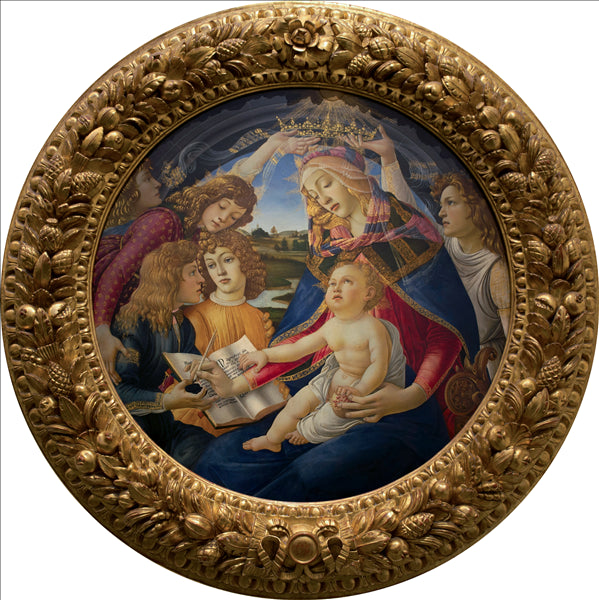描述
Sandro Botticelli's Madonna del Magnificat, painted in 1481, is a brilliant example of the Italian Renaissance, characterized by its deep spirituality and technical mastery. In this painting, Botticelli demonstrates his unique ability to fuse idealized beauty with religious symbolism, creating a dialogue between the heavenly and the earthly.
The central focus of the composition is the figure of the Virgin Mary, who holds the Child Jesus in her arms. Both figures are surrounded by a group of angels and martyrs, each representing a visual and symbolic harmony within the work. The Virgin, with a serene and contemplative expression, reflects this duality of the human being facing divinity. Her posture, leaning over the book held by the archangel, suggests a connection between knowledge and divinity, underlining the message of the Magnificat, Mary's song of praise.
The color palette chosen by Botticelli is rich and vibrant. The blue tones used for Mary's clothing contrast strikingly with the warm golds and reds that adorn the angels' garments. This use of color emphasizes not only the figure of the Virgin, but also creates an emotional landscape that invites the viewer to participate in the devotion of the moment. The luminosity of the colors generates an almost ethereal atmosphere, elevating the scene toward the divine.
The composition of the work is balanced and harmonious, a characteristic feature of Botticelli's style. The use of spiral and circular shapes guides the viewer's gaze naturally towards the centre of the painting. This compositional organisation is not only aesthetically pleasing, but also has a symbolic function: it represents the continuous connection between the earthly and the divine, time and eternity.
The figures of the angels, who seem to float in an almost unattainable balance, add to this sense of immateriality. Their expressions and postures are adoring, and each one seems to be immersed in his own reverence towards the Virgin and her Son. The interaction between the characters is a distinctive Botticelli characteristic; the angels are not mere decorative figures, but actively participate in narrating the story of salvation.
Another intriguing aspect of "Madonna of the Magnificat" is its historical context. Painted at a time when Florence was in the midst of cultural and religious renewal, this work could be interpreted as a reflection of the spiritual fervor of his time, and the search for beauty and knowledge. Botticelli, influenced by Renaissance humanism, combines religious devotion with an interest in nature and the human figure in his work, bridging the gap between medieval tradition and the new Renaissance approach to art.
Although the Madonna del Magnificat has been the subject of study and admiration throughout the centuries, it continues to provoke questions about the artist's intent and the interpretation of its visual symbols. Through his technical mastery and spiritual sensitivity, Botticelli gave the world a work that remains a testament to the profound connection between art, religion and human experience, inviting each observer to reflect on the meaning of divinity in their own lives.
KUADROS ©, a famous painting on your wall.
Hand-made oil painting reproductions, with the quality of professional artists and the distinctive seal of KUADROS ©.
Painting reproduction service with satisfaction guarantee. If you are not completely satisfied with the replica of your painting, we will refund 100% of your money.

